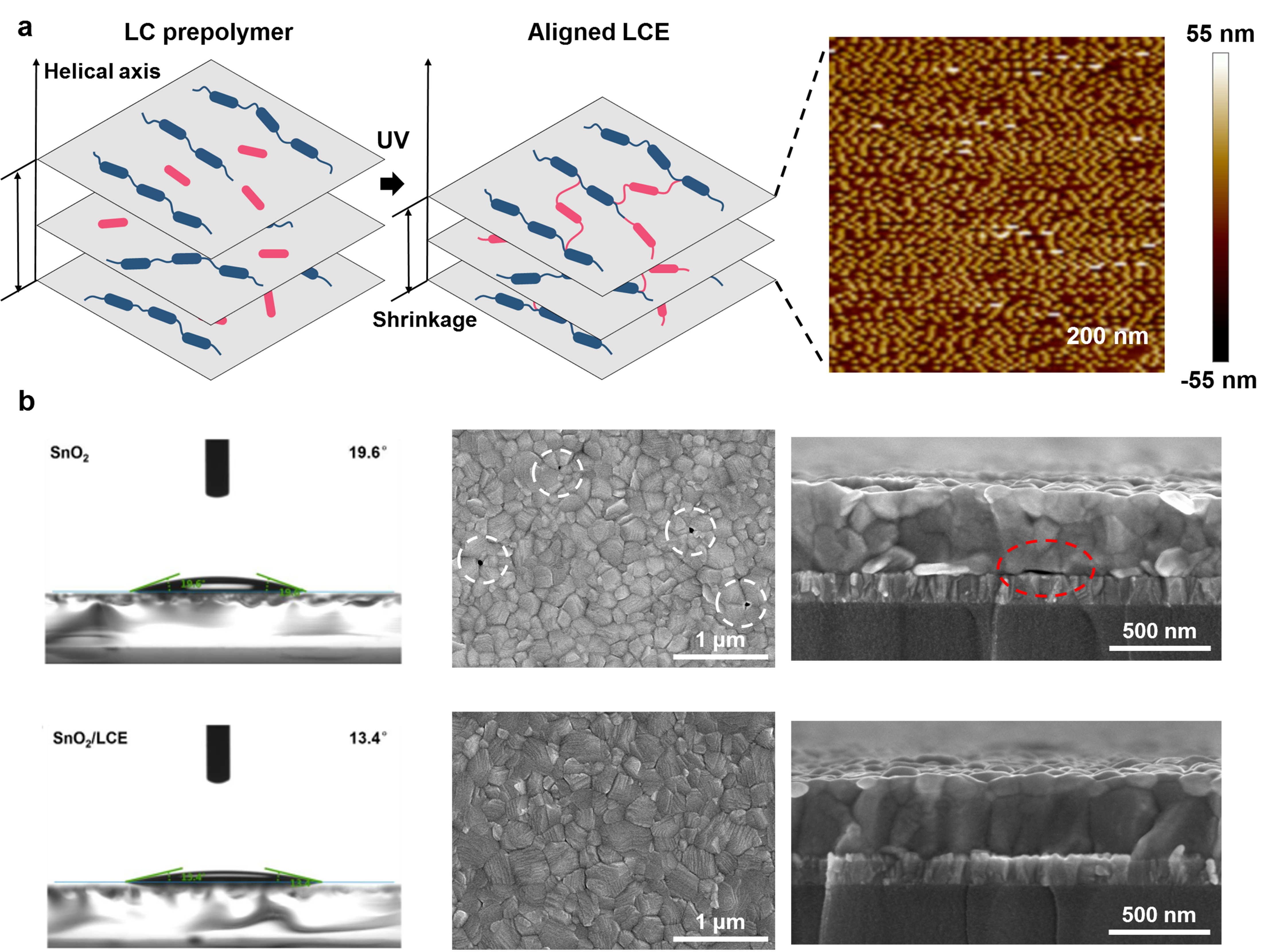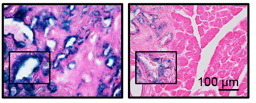Wearable perovskite solar cells by aligned liquid crystal elastomers
Published in Materials

Flexible perovskite solar cells (PSCs) have attracted extensive interest as the next-generation photovoltaic technology. However, their commercialization has been impeded by undesirable reliability with respect to long-term operational stability and mechanical endurance, which mostly originates from defects that aggregate at layer interfaces in typical PSCs. The charge accumulation due to the imperfect electronic contact at the electron-transport layer (ETL)/perovskite interface (bottom interface) is more significant than that at the perovskite/hole-transport layer (HTL) interface.
We posited that a high concentration of defects (specifically deep-level defects) at the bottom interface may contribute to irreversible degradation of flexible PSCs.
Therefore we explored the goal of more robust interfacial contact between ETL and perovskite layer. We found that using a well-aligned liquid crystal elastomer (LCE) can simultaneously maintain excellent charge collection and minimize charge recombination at the bottom interface. The molecular ordering is instantly locked upon photopolymerization of liquid crystalline diacrylate monomers and dithiol-terminated oligomers. It provides high surface energy and nucleation density, which promote the film densification process (Figure 1).

Figure 1. Molecular ordering and film densification process. a Schematic illustration of aligned-LCE assembled via photopolymerization from randomly orientated LC prepolymer. b The smaller contact angle results in a smaller f(θ) and reduced Gibbs free energy, thereby assisting the nucleation process for the heterogeneous nucleation.
Uniform charge transfer channels are configured by the molecular ordering interlayer, which not only reduces the non-radiative interfacial recombination but also promotes the photogenerated charge transfer to the electrode. The tDOS, as a function of the defect energy, demonstrates a reduction in trap states for the SnO2/LCE based device compared with the SnO2 based device. On account of the same perovskite composition and film architecture, the reduced trap density can be mainly ascribed to the ordered LCE interlayer that results in robust interfacial contact. (Figure 2).

We report particularly high performance and durable flexible PSCs as well as integrated wearable devices using this new strategy (Figure 3). The resultant rigid and flexible PSCs show efficiency up to 23.26% and 22.10%, respectively. The LCE-induced suppression of phase segregation endows the unencapsulated device maintaining >80% of the initial efficiency for 1570 h. Moreover, the aligned elastomer interlayer preserves the configuration integrity with remarkable repeatability and mechanical robustness, which enables the flexible device to retain 86% of its original efficiency after 5000 bending cycles. The reliable solar cell chips are integrated into a wearable haptic device with microneedle-based arrays of sensors to demonstrate a pain sensation system in virtual reality.

Figure 3. Performance of PSCs. a J-V curves of the champion PSC devices based on reference, LC oligomer, and LCE. b Continuous operational stability of the unencapsulated PSC devices based on reference and LCE under flowing N2. c J-V curves of the champion flexible PSCs based on LCE and reference, respectively. d Normalized average PCE values for flexible PSCs as a function of bending cycles with the bending radius of 4 mm. e Photographic image of the IoT system based on flexible PSCs under ambient light. The inset shows the wearable haptic device. f Time-dependent voltage for continuous tracking of the IoT system. The inset shows the light-on photovoltage. g Mechanical bending test for the integrated wearable device under continuous illumination. The inset shows the schematic illustrations of the integrated device under tension or compression strain.
This work titled “Wearable perovskite solar cells by aligned liquid crystal elastomers” was published in the latest volume of Nature Communications journal (https://www.nature.com/articles/s41467-023-36938-7).
Follow the Topic
-
Nature Communications

An open access, multidisciplinary journal dedicated to publishing high-quality research in all areas of the biological, health, physical, chemical and Earth sciences.
Related Collections
With Collections, you can get published faster and increase your visibility.
Clinical trials 2025
Publishing Model: Open Access
Deadline: Dec 31, 2025
Women's Health
Publishing Model: Hybrid
Deadline: Ongoing




Please sign in or register for FREE
If you are a registered user on Research Communities by Springer Nature, please sign in